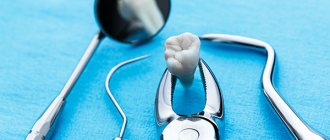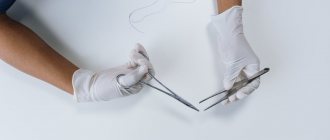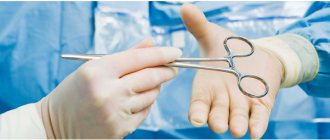Immersion of a dental implant into bone tissue is a surgical operation. During this procedure, the dentist cuts the soft tissue and removes the mucoperiosteal flap to gain access to the bone. After all installation procedures are completed, the gum is sutured to protect the implant installation area from infection. As a rule, sutures are removed after implantation no earlier than 7 days. Most often on the 10–14th day. These deadlines may vary in each individual case.
The need for suturing in dentistry
Surgical intervention and, as a consequence, suturing are indicated for the following manipulations:
- Removal of wisdom teeth - third molars differ from the rest in the large size of the tooth crown and its root. Late eruption, the position of the “extreme” in the dentition very often leads to a violation of the physiological location of the tooth or even its impaction (partial or complete failure to erupt). In this regard, the procedure for removing a wisdom tooth is often accompanied by complications - extensive damage to the soft tissues of the oral cavity and alveolar process, ligaments, and blood vessels. To avoid this kind of consequences, dentists apply stitches to reduce the wound.
- Implantation - its implementation is always accompanied by the need for surgical intervention. A deep incision in the gum requires suturing.
- Maxillofacial operations - elimination of the consequences of traumatic injuries, congenital defects of the dentofacial apparatus.
- Removal of tumors of various etiologies - the integrity of the soft tissues of the oral cavity is damaged, often requiring layer-by-layer sutures.
Diagnosis and treatment
After examining the patient, the doctor will prescribe a histological examination that will help differentiate atheroma from limoma, hygroma and fibroma.
The main treatment method is surgery, during which the tumor will be removed. The intervention takes place under local anesthesia in a hospital setting. The surgeon makes an incision through which the atheroma is removed. The wound is sutured and a sterile dressing is applied. The stitches are removed on the 10th day.
Laser removal of a tumor can be carried out in three ways: photocoagulation, laser evaporation of the capsule, laser excision with the shell.
Radio wave removal is indicated for small atheroma sizes. Radio waves affect tumor cells, causing them to die. A crust forms at the site of the cyst, which disappears over time. Your doctor will tell you more about how radio wave removal of atheroma on the back is carried out during your consultation.
After removal:
- The area after surgery should not be wetted for three days;
- the wound is treated daily with an antiseptic;
- You must wear a bandage for a week;
- It is mandatory to take antibiotics (as prescribed by a doctor);
- During the recovery period, a course of physical therapy is recommended.
The wound healing time depends on the location and size of the cyst.
Types of sutures and materials used in dentistry
To facilitate and accelerate the healing process of postoperative wounds in the oral cavity, the following types of sutures are used:
- nodal - used when it is important to ensure equal tension on both edges of the wound (for example, between teeth);
- continuous - when a violation of the integrity of soft tissue occurs along several dental units;
- single - each stitch is knitted separately from each other.
Threads used for suturing in dentistry can be made of absorbable and non-absorbable material.
Absorbable threads:
- from catgut - which contains a foreign protein, which is perceived by the body as a foreign body, and therefore often causes inflammation of the damaged soft tissue of the patient’s oral cavity;
- “Vicryl” is a synthetic material made from polyclatin and polyglycomic acid, which does not cause the risk of developing inflammatory processes even during complex operations.
Threads made of absorbable material do not require the removal of sutures; they disappear within 2-5 weeks.
Material for non-absorbable threads:
- silk is an easy-to-use material, highly durable, but has a significant drawback - it causes inflammatory processes in soft tissues if not removed 7 to 10 days after surgery;
- monofilament is a thread made of polytetrafluoroethylene, which is durable and does not cause inflammation, but has a rigid structure that can damage the mucous membrane. To exclude this possibility, a bandage is applied to the wound surface;
- polyester is a woven thread often coated with silicone for elasticity and smoothness. A very durable material that does not lead to inflammatory processes, but requires careful fixation in the form of knots.
What happens after surgery
After the surgeon has finished working with the ears, suture threads will first be applied to these places, holding the edges of the wound together. Then the patient is put on a special bandage that has a fixing effect. Its main task is to hold the ears in place and protect them from displacement, loss of shape, or infection.
The bandage can be either a regular compression bandage or a mask bandage. The first product looks like a regular decorative headband, is comfortable to wear, has good throughput, i.e. "breathes". The mask bandage covers the entire neck of the patient and passes under the chin, along the ears and through the back of the head. This option is no less reliable and functional, but wearing a mask can be a little difficult in the summer, when the air temperature rises high.
Wearing a bandage after otoplasty is mandatory.
When and how is the procedure for removing sutures in dentistry performed?
The time for suture removal is determined by the dentist, guided by the process of regeneration (healing) of the soft tissues of the mucous membrane, which depends on:
- on the age of the patient;
- complications of surgical intervention;
- presence of complications.
Usually, sutures are removed 5-10 days after they are applied.
The dentist removes sutures as follows:
- the surface of the wound is disinfected with an antiseptic;
- if the patient has a low pain threshold, local anesthetics are used (but usually this is not necessary);
- Using surgical scissors and anatomical tweezers, the dentist carefully cuts and removes the threads from the healed wound;
- a visual examination is carried out to check the integrity of the wound;
- Disinfection of the suture prevents the risk of wound inflammation.
Sometimes sutures are removed due to the risk of suppuration in the area of the operation. In this case, the sutures are removed, sanitizing procedures are performed and appropriate antimicrobial therapy is prescribed.
Suppurating atheroma on the face
Ordinary atheroma in itself is not dangerous. The exceptions are cases of localization on the face and suppuration. Causes of festering atheroma on the face: infection, complications after a poorly performed operation, advanced form of the disease.
Symptoms of the disease:
- general weakness, enlarged regional lymph nodes;
- temperature increase;
- redness in the area of the tumor;
- swelling;
- cyst enlargement.
Treatment of suppurating atheroma is only surgical. The surgical intervention consists of two stages. Your doctor will tell you at a personal appointment about the day on which the sutures are removed after surgery to remove atheroma.
Hygienic oral care after suture removal
To quickly restore the integrity of the soft tissue of the oral cavity, the patient must:
- Use a soft toothbrush to brush your teeth daily;
- use anti-inflammatory rinses;
- rinse the mouth with warm water or a decoction of medicinal herbs after each meal;
- Avoid eating hard, sour, salty, spicy foods that can irritate the mucous membrane.
Timely removal of sutures, maintaining oral hygiene, and performing procedures prescribed by the dentist will ensure good wound healing and speed up recovery.
Possible complications
After otoplasty, as after any other plastic surgery, complications cannot be ruled out. Most complications are the result of the patient's negligence in caring for the operated areas during the rehabilitation period. Complications include:
- asymmetry,
- severe pain,
- high body temperature,
- suppuration and more.
In these situations, you cannot treat yourself. You should definitely consult your surgeon first.
If unusual symptoms appear, you should consult a doctor.
It is important to understand that bruising, swelling and minor pain are not considered complications. These are natural companions to almost any surgical intervention. You can worry if the severity of these effects either does not decrease over a long period of time or increases.
Features of caring for internal sutures (in the vagina and cervix)
Sutures on the internal genital organs made with absorbable threads (such suture material is called catgut, in modern institutions, vicryl or safil) do not require complex manipulations. They do not need to be removed or washed with any solutions; it is enough for the young mother to ensure complete rest and strictly adhere to the rules of personal intimate hygiene so that the infection does not enter the organs of the reproductive system, since discharge in the postpartum period (especially the first twenty days) is a favorable environment for reproduction pathogenic microbes.
Perform any intimate procedures after washing your hands first - this applies to washing your genitals, visiting the toilet, changing sanitary pads, etc. After each visit to the toilet, remove the used pad and wash yourself, so that the direction of movement goes from the vulva to the rectum with warm water and soap.
Remember - the intestinal microflora should under no circumstances get on the genitals, which is why it is so important to follow this sequence of actions. After treating the perineum with water, gently pat it dry with a clean or disposable towel, collecting all the moisture. If you use linen products, change them at least once a day, and more often as they become dirty. Empty your bladder every three to four hours, even if you don't feel the urge to urinate. You will have to avoid taking a bath in the first month after giving birth.
Recommendations in the late period of rehabilitation
The main task is to create conditions for the speedy healing of the auricle. It is necessary to adhere to a diet based on protein foods. Vitamin complexes and mineral supplements are taken upon request.
Walking is allowed for physical activity. Postpone sports activities. Water procedures are limited. You can wash your hair with baby shampoo, avoiding getting water and hygiene products into the ear.
How long the sutures dissolve after otoplasty depends on adherence to the doctor’s instructions. After six months, a suture will finally form at the incision site.
The duration of the late rehabilitation period is 4-6 months. Only after the passage of time can one evaluate the result obtained.
Swelling after dental implantation
In the first three days after implantation, swelling may occur in the gum tissue. This is the body's natural reaction to surgery. Most often, a tumor is an indicator that blood is actively flowing to the operation site.
But if you want to avoid the discomfort caused by swelling, you can reduce the risk of its occurrence. To do this, in the first two days, apply cold to the operation site: for 5-10 minutes with breaks of 20 minutes. Do not apply ice directly to the skin; it is best to wrap it in a towel. In rare cases, the tumor will require the use of antihistamines, antibiotics (to prevent infection) or treatment with antiseptic solutions.
It will also help to avoid swelling by eliminating sudden stress loads on the body: physical overload, hypothermia, overheating.
When to see a doctor
A visit to the surgeon is required if the suture material does not have absorbable properties. In this case, the doctor must remove the threads himself. The patient is strictly prohibited from doing this.
A visit to the surgeon is necessary to re-bandage. In addition, you will have to consult a doctor if any unusual sensations or effects occur - for example, one or more of those mentioned in the previous paragraph.
The result of plastic ear correction is usually visible immediately. But for final tissue engraftment and shrinkage, about 3-6 months should pass. After this period has expired, the final outcome of the operation can be summed up. The patient will have to be patient and listen to his surgeon in everything. However, the result is definitely worth the effort.
Scars (scars) after blepharoplasty of the upper and lower eyelids
Many patients have a question: do scars remain after surgery? Of course they remain. But you shouldn’t be scared, since they are practically invisible and look like a thin strip, and with transconjunctival blepharoplasty they are not there at all.
The next reasonable question is how to remove scars?
It is impossible to completely remove scars; you can make them almost invisible. And for this, after the operation it is necessary to undergo special treatment. And then patient reviews on the quality of scars after blepharoplasty will be 99.9% positive.
photo scars / scars after upper/lower blepharoplasty
And one more question that concerns patients: what should they use to smear the scars after surgery so that they are invisible? Let’s look at these remedies and scar treatment in more detail.
Scar treatment
There are a huge number of different scar care products, including various drugs:
Gel after blepharoplasty
contractubex
It is a combined preparation in the form of a gel, the effect of which is determined by the properties of its constituent components: Allantoin, Heparin sodium, Onion. It has fibrinolytic, anti-inflammatory (due to the extract of Serae bulbs), antithrombotic (due to heparin), and keratolytic effects (due to allantoin). Causes stimulation of cellular regeneration without hyperplasia. Prevents the formation of keloid scars by inhibiting fibroblasts.
dermatix
The drug is in the form of a silicone gel for external use, transparent, colorless and odorless. Consists of a mixture of polymeric organosilicon compounds (polysiloxanes). Helps maintain uniform moisture in the eyelid skin, has a corrective effect on scars after upper and lower blepharoplasty, smoothing and softening them, relieves pain, itching and discomfort, and also reduces skin redness.
Silicone patch
Silicone patches are also a large group of scar care products. But when applied to eyelids, they are not entirely comfortable. The most famous companies on the Russian market are Dermatix and Mepiform.
Enzyme preparations
A group of drugs intended for the treatment of hypertrophic and keloid scars.
longidase
Longidase is a drug whose main active ingredient is the enzyme hyaluronidase. This enzyme
- increases the permeability of connective tissue;
- stops the process of gross scarring by reducing the formation of its own collagen in the cells of the dermis;
- increases the level of elasticity of the skin of the eyelids.
The drug is available in the form of a dry substance in ampoules. Before use, it is dissolved in 2 ml of liquid (saline or 0.25% lidocaine solution) and injected directly into the scar with a needle.
lidase
An enzyme preparation whose main active ingredient is hyaluronidase.
It is known that hypertrophic and keloid scars are formed due to excessive synthesis of hyaluronic acid. With its participation, at an early stage of the wound process, the production of fibroblasts is stimulated, which produce new skin cells in huge quantities.
When lidase is introduced, excess hyaluronic acid is eliminated, since lidase acts on this acid and decomposes it into glucosamine and glucuronic acid. As a result, microcirculation and cell permeability improve in the scar area.
Available in ampoules as a lyophilisate. Before use, like longidase, it is dissolved in saline and injected under the problematic scar. If injections of the drug are painful, it is better to dissolve it in a lidocaine solution.
imoferase
Eye cream after blepharoplasty, like Lidaza, contains the active ingredient Hyaluronidase, which suppresses the growth of connective tissue and reduces swelling.
With a course of treatment, raised scars decrease in volume, pigmentation decreases, and the elasticity of the eyelid skin increases.
A good property of Imoferase Cream is its ability to act on old scars and scars, reducing their density.
Hormonal ointments and suspensions
hydrocortisone
Hydrocortisone ointment has an anti-inflammatory effect and inhibits the growth of connective tissue. It is used after blepharoplasty and eyelid pathology. Hydrocortisone is a glucocorticosteroid, the use of which can cause many side effects. Therefore, the drug can be used only when prescribed by a doctor.
diprospan
The main active substance is the glucocorticosteroid betamethasone, the effect of which is that it stops the pathological growth of scar tissue, causing the scar to become smaller and flatter. The main indication for use is keloid scars. Uncontrolled use can cause tissue atrophy.
After blepharoplasty it is practically not used
Limitations after blepharoplasty
After blepharoplasty, it is necessary to follow the recommendations for a restrictive regime. Below are the dos and don'ts after surgery:
sports and physical activity
During consultations, I always tell you in detail when you can start playing sports after blepharoplasty. In the first days, it is better to avoid any exercise, as this can lead to an increase in blood pressure and provoke bleeding. A home regimen for 2-3 days is recommended. As a rule, after a month you can fully start playing sports and fitness.
solarium
You can visit the solarium 1 month after blepharoplasty, but be sure to cover the eyelid area, otherwise persistent hyperpigmentation may appear.
alcohol and smoking
Many patients are concerned about when they can drink alcohol and smoke cigarettes after blepharoplasty. It’s better not to drink or smoke at all and say “no” to bad habits! But if you really want to, then no earlier than 2 weeks, as they negatively affect healing.
Tan
You can sunbathe in the sun after 1 month, but you need to use sunscreen, otherwise you can get persistent hyperpigmentation
makeup
Many people are interested in when they can paint their eyes after blepharoplasty. Makeup (cosmetics) can be applied within 5-7 days after surgery. It is necessary to pay attention to any redness, and if it appears, you need to remove makeup so as not to provoke an allergic reaction.
Job
You can return to work 3-5 days after blepharoplasty. But if possible, it is optimal to stay at home for 2 weeks.
eyelashes and tattoo
You can get eyelash extensions 1 month after eyelid surgery. Tattooing can be done 1 month after surgery.
lenses and vision
Lenses after upper blepharoplasty can be put on immediately, and after transconjunctival blepharoplasty - after 10-14 days. For a period of up to 2 weeks, it is necessary to exclude working on the computer and phone, reading books, watching TV and giving your eyes rest.
Botox and Dysport
Botox or Dysport can be injected 1 month after blepharoplasty.
sex
There are no strict restrictions on sex
How long does it take to heal?
Bone tissue and gums heal after dental implantation on average from three to six months, and the period is different for the upper and lower jaws. The lower jaw will heal in three to four months, but the upper jaw will take longer: four to six months. This is due to the greater bone density of the lower jaw.
Sometimes the healing rate deviates from the average time frame, because it depends on the individual characteristics of the patient’s body: the speed of regeneration, the strength of the immune system, the pain threshold. Even such factors as gender, age, lifestyle, diet and daily routine of the patient are important.
In any case, recovery after surgery takes some time. Following medical recommendations will help protect yourself from complications during healing.
Techniques used in bone grafting
- Alveolar process resorption is used for horizontal bone splitting when it is necessary to increase the density of the alveolar process. It is performed on both jaws, and today is the most popular method for increasing the volume of the alveolar process, while having a low cost compared to more expensive procedures. Again, there are variations of this technique, but it’s worth paying attention to “Split Control”. The technique makes it possible to simultaneously expand the space and install an implant.
- To increase the volume and length of the alveolar process, a bone block transplantation technique is used. Autogenous material is more often used here. The principle is to screw a bone block taken, for example, from the maxillary region of the zygomatic-alveolar ridge to the bone, using medical mini-screws made of titanium alloy. Then it’s all covered with bone shavings and covered with a connective tissue membrane, which is secured. Subsequently, the surgical wound is tightly sutured with synthetic thread. The disadvantages of autogenous material were discussed above, which should be taken into account when choosing therapy.
- Guided tissue regeneration is a method in which it is possible to both increase the height and expand the volume of the alveolar processes. This technique also involves the simultaneous installation of an implant.
The guided bone regeneration technique includes two components:
- implanted bone material;
- a special barrier membrane that protects against the effects of various infectious agents and other unpleasant factors.
It is important to understand and take into account that the technique of directed bone regeneration does not always provide a sufficient effect. When using this method, bone material is “planted” on the outside of the cortical plate of the upper or lower jaw. The bone structure is very different from its own and is prone to incomplete splitting. Therefore, such an operation should be performed by an experienced doctor who knows all the nuances of the technique and can adequately assess further treatment tactics.
How to remove stitches correctly
In most cases, the use of disinfectants is not necessary; they can irritate the wound and cause discomfort to the dog.
The owner will need:
- Surgical scissors. In the absence of such, you can use a similar model with rounded edges.
- Surgical tweezers.
- Cotton swabs.
- Iodine, chlorhexidine.
- Clean towel (clean rags, gauze).
On the day the sutures are removed, the animal should be calmed so that it does not become nervous. It is enough to hold a small dog by the head with one hand or swaddle it, but with a large one you will have to tinker, quite possibly, ask someone at home for help so that the dog cannot move. Nervous and aggressive dogs should wear a muzzle.
Next, the animal should be placed in a comfortable position so that it lies on its side in a relaxed, natural position.
How to remove post-operative stitches for a dog:
- Clean the healed wound from dried blood and other contaminants using a towel moistened with warm, soapy water.
- Find the longest ends of the threads, pinch them with your left hand and pull them towards you.
- Cut the threads with scissors between the skin and the knot.
- Press the skin next to the seam with the fingers of your right hand, pull the ends of the threads with the fingers of your left hand, and quickly and carefully pull them out.
- If there are threads left at the site of the healed wound, remove them using tweezers.
- Treat the postoperative area with iodine.
This concludes the suture removal procedure, and if the owner did everything correctly, then there should be no complications.
Antibiotics after dental implantation
For preventative purposes, the doctor prescribes a course of antibiotics after surgery. In most cases, this is inevitable, since surgical trauma, even with the modern level of development of medicine, carries a high risk of infection. Therefore, it is better not to ignore antibacterial drugs prescribed by a doctor if you do not want to additionally place unnecessary burden on your immune system to fight infection.
Most often, the course of antibacterial therapy does not exceed 7 days, and broad-spectrum drugs are prescribed - amoxicillin, amoxiclav, cephalosporins. They are characterized by low toxicity and have long proven themselves to be well tolerated by the human body.









